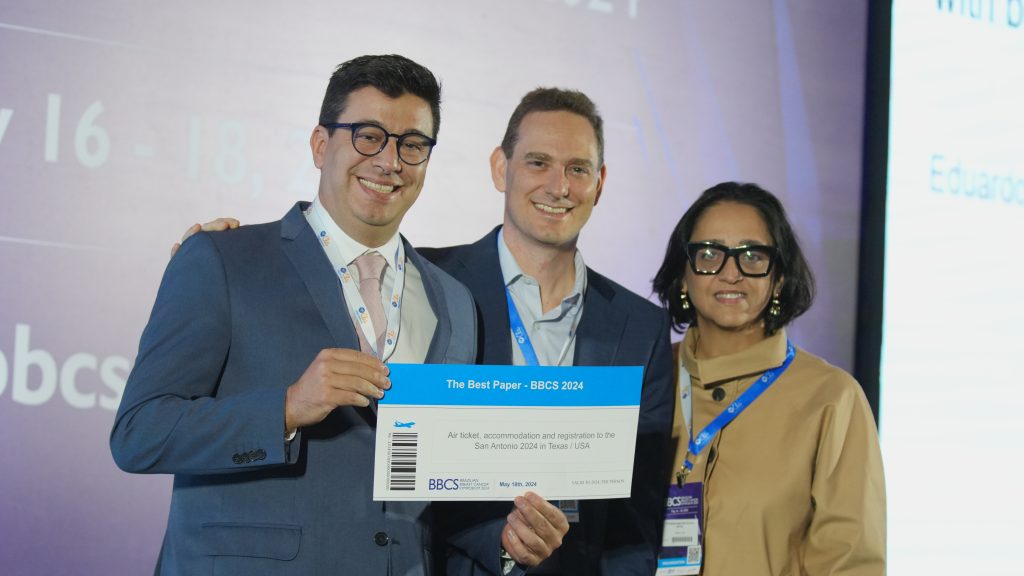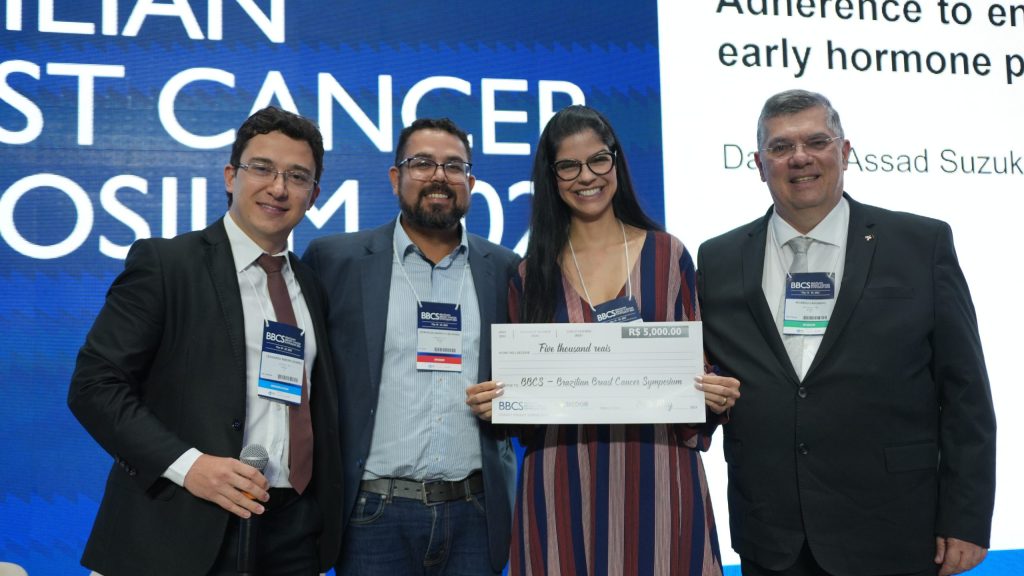
EFFECT OF VITAMIN D SUPPLEMENTATION ON THE PATHOLOGICAL COMPLETE RESPONSE TO NEOADJUVANT CHEMOTHERAPY IN WOMEN WITH BREAST CANCER: A RANDOMIZED CLINICAL TRIAL
Michelle Sako Omodei1; Eduardo Carvalho Pessoa1; Daniel Buttros1; Heloisa De Luca Vespoli1; Jackeline Chimicoviaki1; Benedito Almeida- Filho1; Eliana Nahas1
1 São Paulo State University in Botucatu – Unesp, São Paulo, Brazil.
Objective: To evaluate the effect of vitamin D (VD) supplementation on the pathological complete response (pCR) rate in women with breast cancer (BC) undergoing neoadjuvant chemotherapy (NCT). Methodology: A randomized clinical trial was conducted on 80 women aged ≥45years with a histological diagnosis of BC, who were eligible for NCT. Women were randomized to one of two groups that received either daily supplementation with 2000IU of cholecalciferol (VD,n=40) or placebo (n=40) during the chemotherapy period (6months). The primary outcome measure was pCR. Serum 25-hydroxyvitamin-D [25(OH)D] was measured at two time points, after BC diagnosis and at the end of chemotherapy. Clinical, anatomopathological, immunohistochemical, and chemotherapy data were collected. Per-protocol analysis was performed using Student’s t-test, chi-square test, ANOVA, and logistic regression (OR,odds ratio). Study registration: RBR-10k4gqdg. Results: Seventy-five of the 80 randomized women completed chemotherapy and underwent surgery. Mean baseline 25(OH)D values indicated hypovitaminosis D in both groups (VD group:19.6±5.8ng/mL and placebo:21.0±7.9ng/mL,p=0.331). After 6months of intervention, there was a significant increase in 25(OH)D values in the VD group compared to the placebo (28.0±8.7 vs 20.2±6.1ng/mL,p=0.032). The pCR rate was higher in women supplemented with VD when compared to the placebo (55.3%vs32.4%,p=0.046). In logistic regression analysis adjusted for variables that interfere with pCR (anatomopathological, immunohistochemical, and chemotherapy regimens), women with 25(OH)D values ≥20ng/mL were more likely to achieve pCR than women with VD deficiency (OR0.10, 95%CI 0.02-0.61,p=0.013). Conclusion: In the present study, women with BC undergoing NCT and receiving supplementation with 2,000IU of VD had a higher pCR rate than women in the placebo group. Women with 25(OH)D values >20ng/mL were more likely to achieve a pCR than women with VD deficiency. Our results support the evidence that serum VD levels should be assessed during NCT and supplementation may be beneficial for attaining pCR in women with BC. Further studies are needed to validate these results since confirmation of this finding is of direct clinical relevance and has possible therapeutic implications.
Keywords: Breast cancer; Vitamin D; Pathological complete response; Neoadjuvant chemotherapy

ADHERENCE TO ENDOCRINE ADJUVANT THERAPY IN WOMEN WITH EARLY HORMONE POSITIVE BREAST CANCER
Daniele Assad Suzuki¹, Danielle Laperche dos Santos², Anna Luiza Galvão³, Sulene Cunha Souza Oliveira4, Cristiano de Pádua Souza5, Amanda Guimarães Castro Custódio¹, Romualdo Barroso-Sousa6
¹ Hospital Sírio Libanês|Brasília|Distrito Federal|Brazil
² Hemolabor|Goiânia|Goiás|Brazil
³ UniCeub|Brasília|Distrito Federal|Brazil
4 Liga de Câncer de Natal|Natal|Rio Grande do Norte|Brazil
5 Hospital de Amor|Barretos|São Paulo|Brazil
6 Hospital Brasília, DASA Oncologia|Brasília|Distrito Federal|Brazil
Objective: This study aims to evaluate adherence to adjuvant endocrine therapy in woman with early breast cancer and explore its relationships with patients’ clinical and social characteristics and site of treatment. Methodology: Women with a past history of early-stage estrogen-receptor positive invasive carcinoma of the breast on adjuvant endocrine therapy for at least 6 months were invited to participate of this study. Adherence was assessed with questionnaire MMAS-8. Demographic and clinical information were reviewed from medical records. Data collection performed using RedCap software and statistical analyzes were performed on the software R (R Core Team (2022). Results: From June 2021 to March 2023, a total of 212 patients were recruited in 6 institutions. Median age was 56 years. 29,2% were black. 24,1% were premenopause. 38,2% had stage I disease. 65,1% received chemotherapy. 16,5% received HER2 blockade. Mean duration of endocrine therapy use was 3,7 years. 115 patients (54,2%) used aromatase inhibitors. 24 patients (11,4%) had low adherence, 76 (365) had intermediate and 111 (52,6%) had high adherence to adjuvant endocrine therapy. There is a tendence that more postmenopausal women were classified in high adherence grupo than premenopausal women (55.9% vs 42% p=0,19). There is a tendence that more woman in public service had high adherence than woman in private service (59.3% vs 50.3% p=0.07). There was no difference in adherence in relation to ethinicity, type/duration of endocrine treatment. Conclusion: This study for the first time show that high adherence to endocrine therapy only happens in 52.6% of patients, lower than reported in previous studies. This result draws attention because it can compromise survival. We will continue the recruitment of patients in the private service and in the public service to assess the rate of adherence in a larger population and the relationship with demographic characteristics.
Keywords: Hormone Therapy; Breast Cancer; Medication Adherence